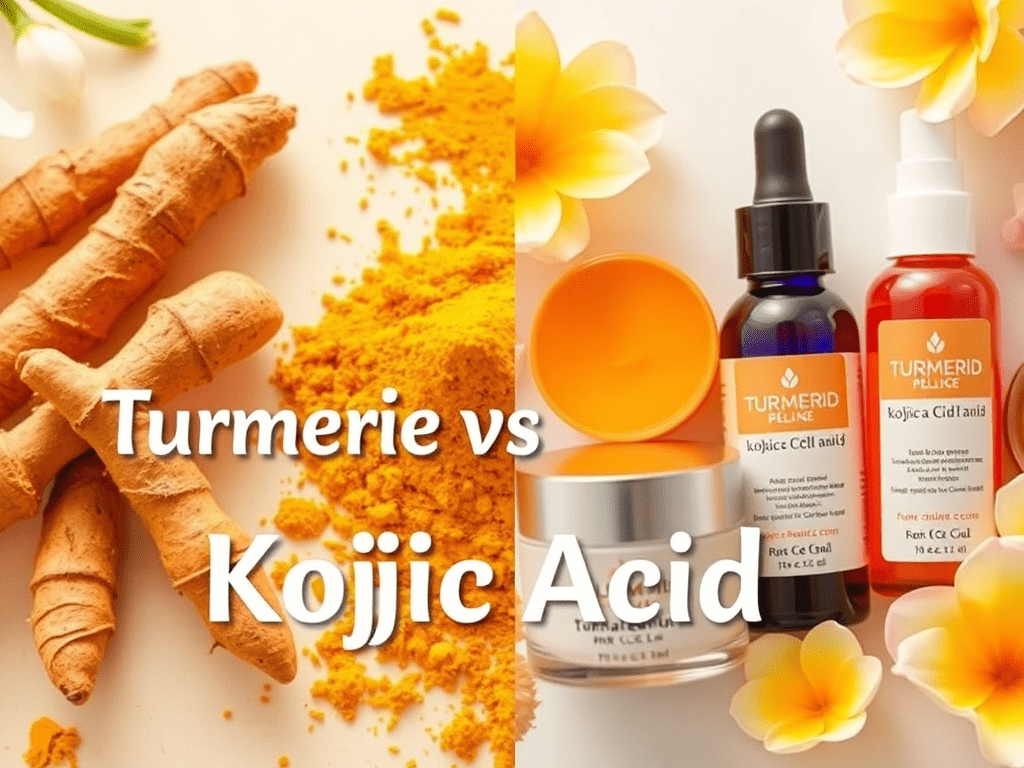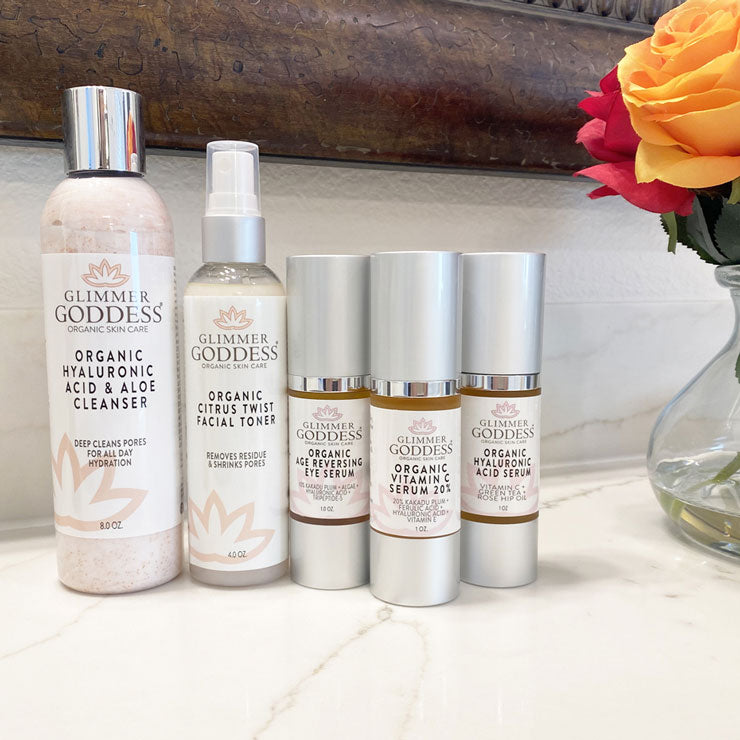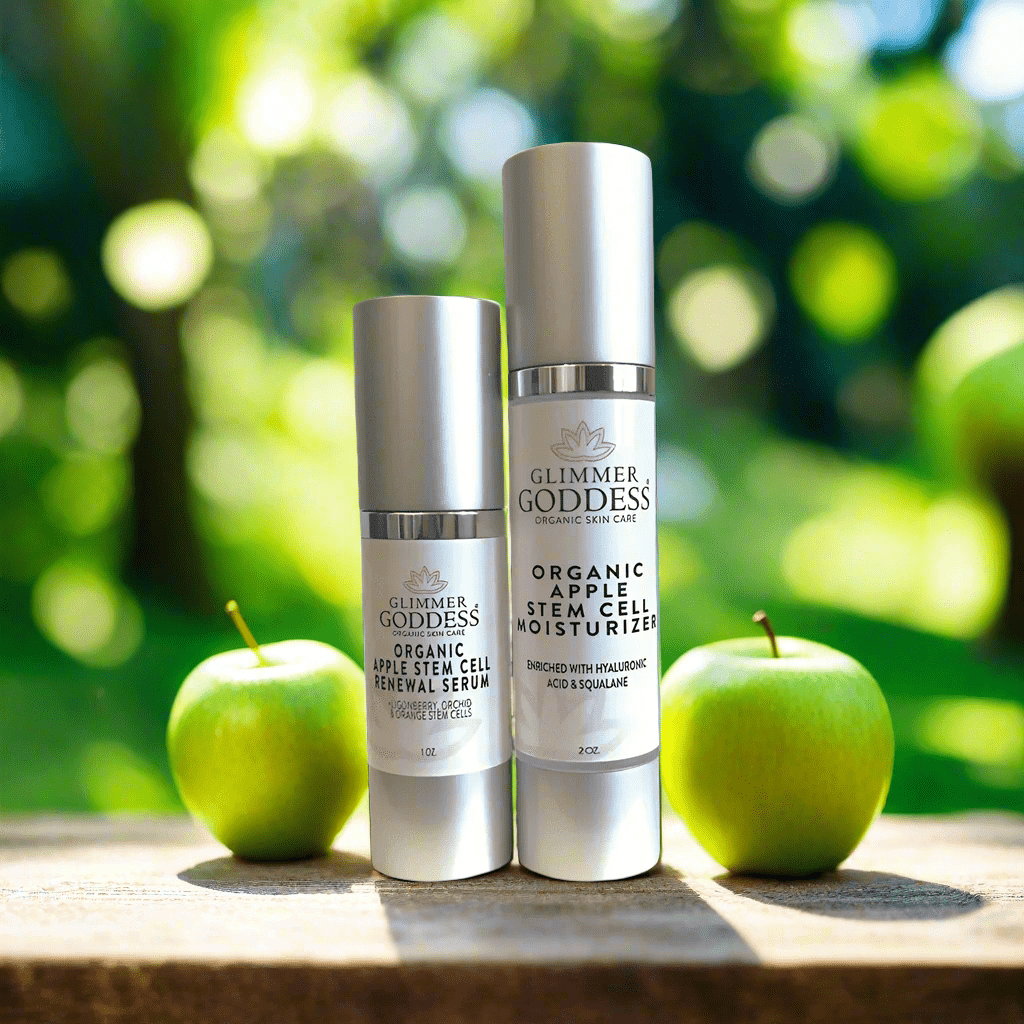
Turmeric vs. Kojic Acid: Brightening Agents Compared — Effectiveness and Sensitivity Guide
In the quest for radiant skin, turmeric and kojic acid have emerged as two powerful contenders. Both natural ingredients claim to enhance skin brightness and reduce pigmentation. This article will explore their unique benefits, mechanisms of action, and how to incorporate them into your skincare routine to achieve a luminous complexion.
The Incredible Skin Brightening Powers of Turmeric
What are the Active Compounds in Turmeric?
Turmeric, a vibrant yellow spice derived from the rhizome of the Curcuma longa plant, has long been hailed for its remarkable medicinal and skin-enhancing properties. At the heart of turmeric's remarkable efficacy are its active compounds, which work synergistically to deliver a wide range of benefits.
The primary active compound in turmeric is curcumin, a polyphenol that exhibits potent antioxidant, anti-inflammatory, and skin-brightening properties.
- Curcumin is responsible for turmeric's distinctive yellow hue and is largely credited for the spice's exceptional therapeutic potential.
- Curcumin has been shown to inhibit the activity of tyrosinase, the enzyme responsible for melanin production, thereby reducing the appearance of skin discoloration and hyperpigmentation.
- In addition to curcumin, turmeric also contains other bioactive compounds such as volatile oils (including turmerone, ar-turmerone, and α-turmerone) and various other curcuminoids, all of which contribute to the spice's multifaceted benefits.
How Does Turmeric Work on Skin Pigmentation?
The skin-brightening effects of turmeric can be attributed to its ability to modulate various cellular and molecular pathways involved in melanogenesis, the process of melanin production.
Turmeric's potent antioxidant and anti-inflammatory properties play a crucial role in its ability to improve skin pigmentation.
- Oxidative stress and inflammation are known to stimulate the activity of tyrosinase, leading to increased melanin synthesis and the development of uneven skin tone, age spots, and other forms of hyperpigmentation.
- Curcumin, the primary active compound in turmeric, has been shown to effectively inhibit the activity of tyrosinase, thereby reducing melanin production and visibly brightening the skin.
- Turmeric also possesses the ability to suppress the transfer of melanosomes (melanin-containing organelles) from melanocytes to surrounding keratinocytes, further contributing to its skin-lightening effects.
What are the Benefits and Side Effects of Using Turmeric?
In addition to its remarkable skin-brightening capabilities, turmeric offers a wealth of other benefits that make it a true superstar in the world of natural skincare.
Turmeric's multifaceted properties extend far beyond its skin-lightening effects, making it a versatile and highly sought-after ingredient.
- Turmeric is a powerful anti-inflammatory agent, capable of reducing redness, swelling, and irritation, making it an excellent choice for those with sensitive or acne-prone skin.
- The antioxidant properties of curcumin help to neutralize free radicals, protecting the skin from the damaging effects of environmental stressors and premature aging.
- Turmeric also possesses antimicrobial and antiseptic properties, which can be beneficial in the treatment of various skin conditions, including eczema, psoriasis, and fungal infections.
While turmeric is generally considered safe for topical use, it is important to be mindful of potential side effects:
- Turmeric may cause temporary staining or discoloration of the skin, particularly if used in high concentrations.
- Some individuals may experience mild skin irritation or allergic reactions, especially those with sensitive skin or a history of allergies.
- Ingesting large amounts of turmeric can potentially interact with certain medications, so it's crucial to consult with a healthcare professional before incorporating turmeric supplements into your regimen.
How Can You Use Turmeric Safely for Skin Brightening?
Incorporating turmeric into your skincare routine can be a simple and effective way to harness its skin-brightening benefits, but it's important to do so safely and effectively.
When using turmeric for skin brightening, it's crucial to start with a low concentration and gradually increase as your skin tolerates it.
- Begin by incorporating a small amount of turmeric powder or a turmeric-based product into your daily cleansing routine, allowing the active compounds to penetrate and work their magic.
- You can also create a simple turmeric face mask by mixing turmeric powder with a carrier oil, such as coconut or jojoba oil, and applying it to clean skin for 10-15 minutes before rinsing.
- For a more targeted approach, consider using a turmeric-infused serum or spot treatment to address specific areas of concern, such as age spots or uneven skin tone.
Turmeric's remarkable skin-brightening abilities, coupled with its multitude of other therapeutic benefits, make it a true powerhouse in the world of natural skincare. By incorporating this versatile spice into your routine and using it safely and effectively, you can unlock the radiant, even-toned complexion of your dreams.
The Incredible Skin-Brightening Powers of Kojic Acid
How Is Kojic Acid Derived and Used?
Kojic acid is a naturally occurring compound that has gained widespread popularity in the cosmetic and skincare industry for its remarkable skin-brightening properties. Derived from several species of fungi, including Aspergillus oryzae, Aspergillus flavus, and Penicillium species, this versatile ingredient has been used in various products from Japan and other parts of Asia for decades.
Kojic acid is primarily produced through the fermentation of starchy substances, such as rice, and is known for its ability to inhibit the production of melanin, the pigment responsible for skin color and tone.
- Traditionally, kojic acid has been used in traditional Japanese and Chinese medicine to treat a variety of skin conditions, including age spots, freckles, and other forms of hyperpigmentation.
- In recent years, kojic acid has been widely adopted by the global cosmetics industry and is now found in a wide range of skincare products, including serums, creams, lotions, and even some makeup formulations.
- The versatility of kojic acid allows it to be used in a variety of applications, from skin lightening and brightening to the treatment of acne and other blemishes.
With its proven efficacy and gentle nature, it's no wonder that kojic acid has become a staple ingredient in many modern skincare routines.
What Are the Mechanisms Behind Kojic Acid's Brightening Effect?
The skin-brightening properties of kojic acid are primarily attributed to its ability to inhibit the production of melanin, the pigment responsible for skin color and tone. Melanin is produced through a process called melanogenesis, which is catalyzed by the enzyme tyrosinase.
Kojic acid works by interfering with the activity of tyrosinase, effectively slowing down the production of melanin and leading to a more even, brighter, and more youthful-looking complexion.
- Kojic acid accomplishes this by chelating copper, an essential cofactor for tyrosinase activity. By binding to the copper ions, kojic acid prevents them from being utilized by the tyrosinase enzyme, which in turn, reduces melanin synthesis.
- Additionally, kojic acid has been shown to possess antioxidant properties, which can help to protect the skin from the damaging effects of free radicals and other environmental stressors that can contribute to the development of hyperpigmentation.
- By inhibiting melanin production and providing antioxidant protection, kojic acid can help to fade the appearance of existing discoloration and prevent the formation of new dark spots or uneven skin tone.
The multifaceted mechanisms of kojic acid make it a powerful and effective ingredient for achieving a more radiant, even-toned complexion.
Are There Any Risks or Side Effects with Kojic Acid?
While kojic acid is generally considered safe for topical use, it is important to be aware of potential risks and side effects associated with its use. Like any active skincare ingredient, it is possible for some individuals to experience adverse reactions or sensitivities.
Some of the potential side effects and risks of using kojic acid-based products may include:
-
Skin irritation, such as redness, dryness, or stinging, particularly with higher concentrations of the ingredient
-
Increased sun sensitivity, which can lead to sunburns or other sun-related skin damage if proper sun protection is not used
-
Potential allergic reactions, especially in individuals with a history of sensitivity to mushrooms or other fungal-derived ingredients
-
In rare cases, the use of kojic acid has been associated with the development of contact dermatitis or other skin inflammation
-
It is important to always conduct a patch test when introducing a new kojic acid-based product to your skincare routine, and to start with lower concentrations to gauge your skin's tolerance.
While the risks are generally low, it is essential to use kojic acid-containing products with care and caution, and to discontinue use if any adverse reactions occur.
How to Incorporate Kojic Acid into Your Skincare Routine?
Incorporating kojic acid into your skincare routine can be a highly effective way to achieve a more radiant, even-toned complexion. However, it is crucial to use the ingredient correctly and in the right formulations to maximize its benefits and minimize the risk of any side effects.
Here are some tips for successfully incorporating kojic acid into your skincare routine:
- Start with a low concentration: When first introducing kojic acid, it's best to use products with a lower concentration of the ingredient, such as 1-2%. This will allow your skin to adjust and minimize the risk of irritation.
- Use it consistently: For optimal results, it's important to use kojic acid-containing products consistently, as it can take several weeks or even months to see the full brightening effects.
- Pair it with complementary ingredients: To enhance the efficacy of kojic acid, consider using it in conjunction with other skin-brightening and soothing ingredients, such as vitamin C, niacinamide, or aloe vera.
- Protect your skin from sun exposure: Since kojic acid can increase sun sensitivity, it's crucial to use a broad-spectrum sunscreen with an SPF of 30 or higher whenever you're using products containing this ingredient.
- Monitor your skin's reaction: Be mindful of any signs of irritation, such as redness, dryness, or stinging, and discontinue use if you experience any adverse reactions.
By following these guidelines and incorporating kojic acid into your skincare routine thoughtfully, you can unlock the incredible skin-brightening benefits of this innovative ingredient and achieve a more radiant, even-toned complexion.
How to Choose Between Turmeric and Kojic Acid?
How to Choose Between Turmeric and Kojic Acid?
When it comes to skin brightening and evening out complexion, two natural ingredients that often come up are turmeric and kojic acid. Both have their own unique benefits and applications, but deciding which one to use can be a challenge. In this article, we'll dive deep into the differences between turmeric and kojic acid to help you make an informed choice.
Turmeric and Kojic Acid: An Overview
- Turmeric is a vibrant, yellow spice that has been used in Ayurvedic medicine for centuries. It contains a powerful active compound called curcumin, which is known for its anti-inflammatory and antioxidant properties.
- Kojic acid, on the other hand, is a natural skin lightening agent derived from various fungi. It works by inhibiting the production of melanin, the pigment responsible for skin color.
- Both turmeric and kojic acid have been touted for their ability to brighten the skin, reduce the appearance of dark spots and hyperpigmentation, and even out the complexion.
What Skin Types Benefit from Each Agent?
Depending on your skin type and concerns, one of these ingredients may be more suitable than the other. Let's explore how they perform on different skin types.
Oily and Acne-Prone Skin
- Turmeric is an excellent choice for oily and acne-prone skin. Its anti-inflammatory properties can help calm inflammation and reduce the appearance of blemishes.
- Kojic acid, while effective for brightening, can sometimes be drying and irritating for those with oily or reactive skin.
Dry and Sensitive Skin
- Kojic acid may be the gentler option for those with dry or sensitive skin. It tends to be less drying and irritating compared to turmeric.
- Turmeric, on the other hand, can be quite drying and may cause irritation in those with delicate complexions.
Mature and Sun-Damaged Skin
- Both turmeric and kojic acid can be beneficial for mature and sun-damaged skin. They can help reduce the appearance of age spots, fine lines, and uneven texture.
- Kojic acid may be the more potent option for targeting stubborn hyperpigmentation and discoloration.
Can You Use Turmeric and Kojic Acid Together or Alternately?
Integrating both turmeric and kojic acid into your skincare routine can be an effective way to tackle a variety of complexion concerns. However, it's crucial to approach this with caution.
Using Turmeric and Kojic Acid Together
- Combining turmeric and kojic acid can potentially lead to increased sensitivity and irritation, especially for those with sensitive skin.
- It's generally recommended to use these ingredients separately, giving your skin a break in between, rather than using them concurrently.
Using Turmeric and Kojic Acid Alternately
- Alternating the use of turmeric and kojic acid can be a more gentle and effective approach. This allows your skin to adapt to each ingredient and minimize the risk of irritation.
- For example, you could use a turmeric-based product in the morning and a kojic acid-based product in the evening, or vice versa, depending on your skin's needs.
What Should Be Considered Regarding Sensitivity and Allergies?
It's crucial to be mindful of potential sensitivity and allergic reactions when using either turmeric or kojic acid.
Sensitivity Concerns
- Turmeric and kojic acid can both be quite potent, and individuals with sensitive skin may experience irritation, redness, or dryness when using these ingredients.
- It's recommended to start with a low concentration and gradually increase, paying close attention to your skin's reaction.
Allergy Considerations
- Some people may be allergic to turmeric or kojic acid, which can result in more severe reactions like itching, swelling, or even anaphylaxis.
- If you have a known allergy to either of these ingredients, it's best to avoid them altogether and consult with a dermatologist for alternative solutions.
In conclusion, both turmeric and kojic acid can be powerful tools in your skincare arsenal, but the choice between the two will depend on your individual skin type, concerns, and tolerance. By understanding the unique benefits and potential drawbacks of each ingredient, you can make an informed decision and achieve the radiant, even-toned complexion you desire.
Unlock Your Skin's Radiant Potential: Discover Our Organic Glow-Boosting Collection
Organic Glow Up Tumeric Vitamin C & E Brightening Face Mask - 2 oz.
Unveil your skin's natural radiance with our Organic Glow Up Turmeric Mask. This powerful blend of Vitamin C and E works to brighten dull complexion, firm sagging skin, and deliver an enviable glow. The turmeric-infused formula targets uneven skin tone while nourishing ingredients restore elasticity. Transform your skincare routine with this 2 oz jar of pure, organic brilliance – your path to luminous, rejuvenated skin awaits.
Formulated with Organic Tumeric, Raw Vitamin C, Organic Camu Camu, Vitamin E and amino acids, this mask softens, exfoliates skin and protects skin from free-radical damage while tightening, detoxifying, and restoring the appearance of a firm, youthful, radiant complexion.
- Organic turmeric is a powerful antioxidant that helps even out skin tone, reduce the appearance of blemishes, and impart a natural, healthy glow.
- Raw Vitamin C from Camu Camu brightens the complexion, fades dark spots, and boosts collagen production for a more youthful, firmer appearance.
- Vitamin E nourishes and protects the skin, combating environmental stressors and restoring suppleness.
- Amino acids provide deep hydration, plumping and smoothing the skin's surface for a radiant, lit-from-within look.
- The creamy, luxurious texture of this mask melts seamlessly into the skin, delivering a spa-like experience in the comfort of your own home.
Q&A
What are the main benefits of turmeric for skin?
Turmeric is known for its anti-inflammatory, antioxidant, and skin-brightening properties. It can reduce redness, fight acne, and improve uneven skin tone due to its active compound, curcumin.
How does kojic acid help in skin brightening?
Kojic acid inhibits the enzyme tyrosinase, which is responsible for melanin production. By slowing down melanin synthesis, it helps in lightening dark spots and evening out skin tone.
Can I use turmeric and kojic acid together?
While it's possible to use both, it's recommended to alternate between them to avoid irritation, especially for sensitive skin types.
Which ingredient is better for oily skin?
Turmeric may be a better choice for oily and acne-prone skin due to its anti-inflammatory properties that can help calm breakouts.
Are there any side effects associated with turmeric?
Turmeric can occasionally cause skin staining or irritation in some individuals, especially in high concentrations. It's important to perform a patch test before widespread use.
Both turmeric and kojic acid offer significant benefits for brightening the skin and evening out tone. Choosing between them depends on your skin type and specific concerns. By understanding how each ingredient works and how to safely use them, you can elevate your skincare routine and achieve a glowing complexion.








